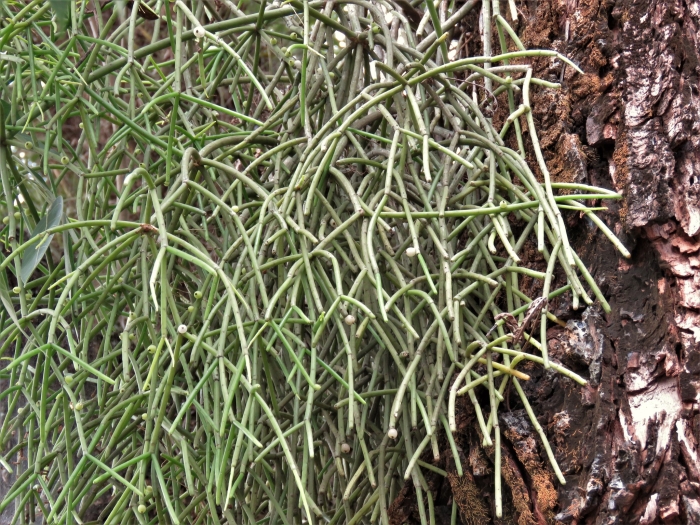Mistletoe Cactus
(Rhipsalis baccifera)
Mistletoe Cactus (Rhipsalis baccifera)
/
/

Annika Lindqvist
CC BY 4.0
Image By:
Annika Lindqvist
Recorded By:
Copyright:
CC BY 4.0
Copyright Notice:
Photo by: Annika Lindqvist | License Type: CC BY 4.0 | License URL: http://creativecommons.org/licenses/by/4.0/ | Rights Holder: Annika Lindqvist | Publisher: iNaturalist | Date Created: 2019-07-02T13:57:22-07:00 |
























Estimated Native Range
Summary
Rhipsalis baccifera, commonly known as the Mistletoe Cactus, is an epiphytic cactus native to rainforests and tropical areas in Central and South America, the Caribbean, and Florida. It has also been found in parts of Africa and Sri Lanka, likely dispersed by migratory birds or through human activity. This species exhibits significant polymorphism, resulting in a variety of subspecies. Rhipsalis baccifera is unique as the only cactus species naturally occurring outside the Americas.
The Mistletoe Cactus has slender, pendant, green to yellow-green stems that can reach lengths of several feet, creating a cascading effect. It produces small, white or pinkish flowers followed by berry-like fruits, which are not particularly showy but add to the plant’s delicate charm. Flowering typically occurs in late winter to spring. In cultivation, it is valued for its low maintenance and suitability for growing in hanging baskets or as an epiphytic addition to larger plants. It thrives in bright, indirect light and requires well-draining soil, high humidity, and regular watering, though it is tolerant of short dry spells. Overwatering can lead to root rot. It is commonly used as an indoor ornamental plant, particularly in areas where outdoor cultivation is not possible due to colder climates.CC BY-SA 4.0
The Mistletoe Cactus has slender, pendant, green to yellow-green stems that can reach lengths of several feet, creating a cascading effect. It produces small, white or pinkish flowers followed by berry-like fruits, which are not particularly showy but add to the plant’s delicate charm. Flowering typically occurs in late winter to spring. In cultivation, it is valued for its low maintenance and suitability for growing in hanging baskets or as an epiphytic addition to larger plants. It thrives in bright, indirect light and requires well-draining soil, high humidity, and regular watering, though it is tolerant of short dry spells. Overwatering can lead to root rot. It is commonly used as an indoor ornamental plant, particularly in areas where outdoor cultivation is not possible due to colder climates.CC BY-SA 4.0
Plant Description
- Plant Type: Succulent
- Height: 3-6 feet
- Width: 1.5-2 feet
- Growth Rate: Moderate, Slow
- Flower Color: White
- Flowering Season: Spring
- Leaf Retention: Evergreen
Growth Requirements
- Sun: Part Shade
- Water: Low, Medium
- Drainage: Fast, Medium
Common Uses
Low Maintenance, Potted Plant, Street Planting
Natural Habitat
Native to rainforests and tropical areas in Central and South America, the Caribbean, and Florida, with occurrences in Africa and Sri Lanka
Other Names
Common Names: Mistletoe Cactus , Wickerware Cactus , Etschwela Lo Boliki , Ilai , Lebambula , Milembo , Spaghetti Cactus , Ndiondio
Scientific Names: Rhipsalis baccifera , Cassytha baccifera , Cassytha baccifera , Cassytha baccifera , Cereus baccifer , Cereus bacciferus , Hariota cassutha , Hariota cassytha , Rhipsalis bermejensis , Rhipsalis cassutha
GBIF Accepted Name: